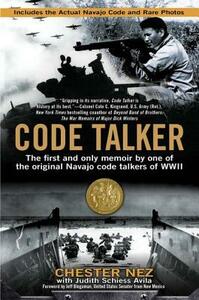Take a photo of a barcode or cover
I found the writing disjointed and casual. But — as Judith Schiess Avila notes in the prologue — this story goes so much further because it’s the ONLY firsthand account by a code talker. There is no better author to tell this than Chester Nez himself. The words may be imperfect, but they are his. To hear Mr Nez explain the contrast between the unwritten Navajo language and English — which he was forced to learn in school as a manner of assimilation — I’m reflecting on the fact he authored a book in his non-native language. It’s remarkable.
Even more remarkable is his resolve. I never realised the vitality of this Navajo code in the Pacific war efforts, let alone the fact that these heroic men lived anonymously because their work was classified for so long. The mere fact these Navajo men took so much pride in defending a country that so terribly mistreated their people is confounding. And yet, Chester Nez relives it to help pass along a vital story in our nation’s history.
The gravity of this story far outweighs its simplistic prose. It’s a must-read for anyone like me, who knows little about the history of Indigenous People, and knew less yet about Navajo code talkers. Firsthand historical accounts, especially lesser-known subjects, are so damn important, and I admire Chester Nez for his courage and his willingness to share his life experience.
Even more remarkable is his resolve. I never realised the vitality of this Navajo code in the Pacific war efforts, let alone the fact that these heroic men lived anonymously because their work was classified for so long. The mere fact these Navajo men took so much pride in defending a country that so terribly mistreated their people is confounding. And yet, Chester Nez relives it to help pass along a vital story in our nation’s history.
The gravity of this story far outweighs its simplistic prose. It’s a must-read for anyone like me, who knows little about the history of Indigenous People, and knew less yet about Navajo code talkers. Firsthand historical accounts, especially lesser-known subjects, are so damn important, and I admire Chester Nez for his courage and his willingness to share his life experience.
adventurous
informative
reflective
medium-paced
informative
inspiring
reflective
medium-paced
adventurous
informative
inspiring
reflective
tense
slow-paced
informative
reflective
medium-paced
I’d heard of the Navajo code talkers but knew very little about them.
It turns out that the code was more complicated and demanding than I understood. I thought the “code” was just speaking in Navajo. No, it was more complicated. Each letter in an English word was represented by a Navajo word, and these disconnected Navajo words were spoken. Say you had to transmit a message that began with the word “attack.” The letter “a” was represented by the word “ant” which, in Navajo, was “wol-la-chee.” Next you would encode the letter “t”, which was represented by the English word “tea”, which, in Navajo, was “d-ah.” So the transmitter would have to say “wol-la-chee d-ah” and the code listener would have to translate the Navajo word into the English word, then the English letter.
The code was actually even more complicated and demanding to both transmit and decode (there were abbreviations for common words and alternate words for most letters) but you get the idea. It was a lot to learn and remember.
Now think about encoding (“talking”) and decoding while sitting in the middle of a battle, with bombs dropping and bullets whistling. Think about doing that when you were hungry and filthy and your feet were tender and infected because you’d been wearing wet socks for the past three weeks. Think about living in a battle zone week after week, always afraid that a Japanese suicide fighter would be dropping into your midst yelling “banzai” and determined to disembowel you before you killed him.
I am high strung by nature. I would be utterly useless in this situation. The values that helped Chester Nez and his fellow code talkers endure (“you’re a Marine and you’re tough”) would mean nothing to me. The Marines endured these hellish conditions for months. I would be suicidal after five minutes.
But we sensitive intellectuals are not completely useless. Because if Chester Nez sat down with me, he’d be probed about why things happened, not just what happened. We would talk about PTSD. I’d research treatments and have some data on the effectiveness of traditional ceremonies like the sing. I’d ask how long the first sing ceremony was effective against his PTSD, and why the ineffective second ceremony wasn’t followed by a third. I’d want to know why his wife left him. I’d ask about the diabetes. I’d have statistics on the incidence of alcoholism and diabetes in native populations.
In short, you’d have context and analysis and meaning.
This story lacks those elements. But it’s stilll a good story, one that needs telling.
It turns out that the code was more complicated and demanding than I understood. I thought the “code” was just speaking in Navajo. No, it was more complicated. Each letter in an English word was represented by a Navajo word, and these disconnected Navajo words were spoken. Say you had to transmit a message that began with the word “attack.” The letter “a” was represented by the word “ant” which, in Navajo, was “wol-la-chee.” Next you would encode the letter “t”, which was represented by the English word “tea”, which, in Navajo, was “d-ah.” So the transmitter would have to say “wol-la-chee d-ah” and the code listener would have to translate the Navajo word into the English word, then the English letter.
The code was actually even more complicated and demanding to both transmit and decode (there were abbreviations for common words and alternate words for most letters) but you get the idea. It was a lot to learn and remember.
Now think about encoding (“talking”) and decoding while sitting in the middle of a battle, with bombs dropping and bullets whistling. Think about doing that when you were hungry and filthy and your feet were tender and infected because you’d been wearing wet socks for the past three weeks. Think about living in a battle zone week after week, always afraid that a Japanese suicide fighter would be dropping into your midst yelling “banzai” and determined to disembowel you before you killed him.
I am high strung by nature. I would be utterly useless in this situation. The values that helped Chester Nez and his fellow code talkers endure (“you’re a Marine and you’re tough”) would mean nothing to me. The Marines endured these hellish conditions for months. I would be suicidal after five minutes.
But we sensitive intellectuals are not completely useless. Because if Chester Nez sat down with me, he’d be probed about why things happened, not just what happened. We would talk about PTSD. I’d research treatments and have some data on the effectiveness of traditional ceremonies like the sing. I’d ask how long the first sing ceremony was effective against his PTSD, and why the ineffective second ceremony wasn’t followed by a third. I’d want to know why his wife left him. I’d ask about the diabetes. I’d have statistics on the incidence of alcoholism and diabetes in native populations.
In short, you’d have context and analysis and meaning.
This story lacks those elements. But it’s stilll a good story, one that needs telling.
This story is truly incredible and my heart breaks for the Navajo (and all native people) for the way that our government has treated them. I'm grateful for the Code Talkers' sacrifices and bravery, and I have learned a lot of history from this book. I'm glad that we were able to immortalize at least one of the stories of these amazing primary sources before they all passed away.
I wish, however, the author of the book had done a better job of painting the story as a complete memory with colors, sights, sounds, and emotions. I got the impression that this book, although told in first person by Chester Nez, it was more of a textbook timeline of a series of events than a memory. Things were glossed over that I felt would have helped me connect in a deeper way to Chester Nez.
As a side note, I personally knew Allen Dale June at the end of his life. He was one of the original 29. My mother met him and his wife, Virginia, at a Veteran's Day parade in Longmont, CO. They were living in a trailer home in Longmont and planned to attend an unceremonious Thanksgiving Dinner at the VA, when my mother invited them to join us instead. Allen "Pops" and Virginia were deeply proud of their Navajo roots, and extremely loving people, but even in the short time I knew Pops, I knew that he was very guarded about his experience in the war. I'm proud to have known him, but I wish I knew more of the details. I hoped to get some of those details from this book, and I'm sad to say that I still feel like I'm missing so much.
I wish, however, the author of the book had done a better job of painting the story as a complete memory with colors, sights, sounds, and emotions. I got the impression that this book, although told in first person by Chester Nez, it was more of a textbook timeline of a series of events than a memory. Things were glossed over that I felt would have helped me connect in a deeper way to Chester Nez.
As a side note, I personally knew Allen Dale June at the end of his life. He was one of the original 29. My mother met him and his wife, Virginia, at a Veteran's Day parade in Longmont, CO. They were living in a trailer home in Longmont and planned to attend an unceremonious Thanksgiving Dinner at the VA, when my mother invited them to join us instead. Allen "Pops" and Virginia were deeply proud of their Navajo roots, and extremely loving people, but even in the short time I knew Pops, I knew that he was very guarded about his experience in the war. I'm proud to have known him, but I wish I knew more of the details. I hoped to get some of those details from this book, and I'm sad to say that I still feel like I'm missing so much.
adventurous
challenging
emotional
informative
inspiring
reflective
slow-paced
hopeful
informative
inspiring
reflective
sad
medium-paced
Chester Nez was one of the original code talkers during World War II. Along with the others, he helped develop the code that remained unbreakable throughout the way, and until it was no longer in use. After helping to develop the code, he spent the rest of his time in the military in the Pacific Theatre, using the code to protect American intelligence, and preserve American lives. He comes across as faithful to Navajo traditions, and both humble and hard-working in his own right.
Excellent biography based on extensive interviews with Chester Nez himself. Describes his childhood and teenage years, which directly influenced his ability to help create and then use the Navajo code in WWII. Recounts his activities during the war, and then more briefly describes his life after the war. Well-written, and there is nothing better than hearing directly from the subject of the biography.
Excellent biography based on extensive interviews with Chester Nez himself. Describes his childhood and teenage years, which directly influenced his ability to help create and then use the Navajo code in WWII. Recounts his activities during the war, and then more briefly describes his life after the war. Well-written, and there is nothing better than hearing directly from the subject of the biography.




